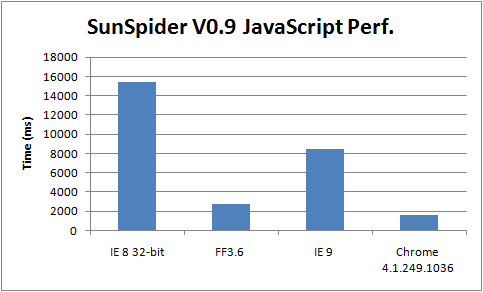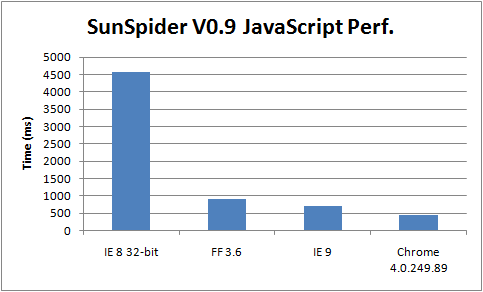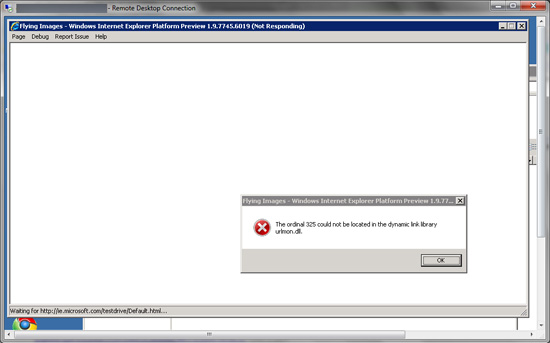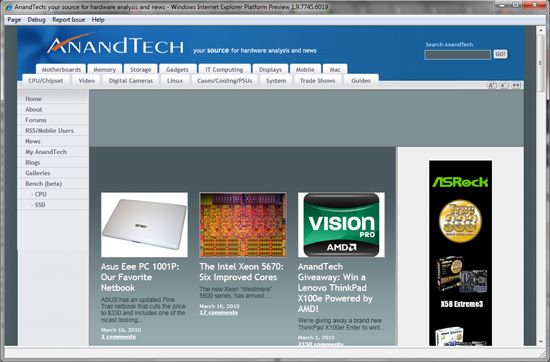Internet Explorer 9 Platform Preview: Investigated
by Brian Klug on March 17, 2010 11:44 AM EST- Posted in
- Trade Shows
Yesterday, Microsoft launched the Internet Explorer 9 Platform Preview at MIX10. Though the current release of the platform preview is very rough around the edges, it promises to bring Internet Explorer into full web standards compliance, partially erasing the web-standard scourge that IE 6 still scandalizes on the internet. Some of the biggest applause-drawing moments happened when IE team members themselves mentioned how important rapid migration away from IE 6 is. What that means is W3C compliance is a very real and important goal, including complete support for HTML5, CSS3, SVG, XHTML, and H.264/MPEG4 HTML5 <video> playback. At the same time, Microsoft hopes to gain valuable insight from web developers about what direction the IE team should take.
JavaScript Performance
But some of the strongest focus of the IE9 platform preview is targeted towards raising the so-called "glass ceiling" on web browsing performance. Microsoft hopes to drive that performance cap higher half through GPU-acceleration for rendering 2D, 3D, and HTML <video> content, and the other half through an entirely new multithreaded JavaScript engine codenamed "Chakra."
Microsoft provided a number of slides comparing JavaScript performance of IE 9 in its current preview, and claims it's at party with Firefox 3.6 and nearly as good as Chrome 4.0.249.89 (stable) tested with SunSpider 0.9:

I initially attempted to validate and reproduce these results on my Latitude XT, and saw something very strange:

I ran and re-ran the test several times; for whatever reason, IE 9 Platform Preview doesn't like my Latitude XT running Windows 7 with a Core 2 Duo U7600 with 3 GB of RAM. Puzzled by the discrepancy, I ran the same tests on another computer running Windows Server 2008 R2 with a Celeron E3400 2.6 GHz with 4 GB of RAM. This CPU is essentially a Core 2 Duo with just 1 MB of L2 cache.
The results were much better:

I realize there's a slight discrepancy between the builds of Chrome on each test bed, however the JavaScript engine itself remains relatively unchanged; performance is on a nearly identical level. Obviously, something on the notebook hinders IE 9's performance dramatically.
Another interesting benchmark we considered was how well IE 9's codename "Chakra" JavaScript engine scales per thread. I was in the process of firing up IE 9 platform preview again to evaluate SunSpider results with different processor affinities toggled, when I was greeted with this:

Uh oh
Considering how early of a preview this is, it's completely understandable that not everything is working properly across every system configuration. I've submitted feedback and a bug report, and plan on continuing to investigate the discrepancy.
It's important to note that IE9 in its current form isn't really a beta, it's somewhere between an alpha and a beta. Microsoft describes this release as "just enough of a slice of the browser" to both let web developers and designers try the new rendering engine, flesh out what HTML5 markup is most favored, and start to get feedback flowing. There's nothing in the way of a back button, tabs, address bar, or favorites. It's just a barebones Trident-wrapper that gives a relatively complete perspective on the direction Microsoft hopes to take IE. They promise to adhere to a strict eight-week schedule for updating the platform with improvements, addressing issues at each step, and increasing their Acid3 score every step of the way. More on that later.
Initial Perspective
But enough with that, let's take a look at it by loading anandtech.com:

It throws an error about scripts; again, there are bound to be problems given the massive rewrite of the JavaScript engine, but otherwise it seems to run. Other than that, yeah, the UI exactly what you see: totally bare-bones. Control-O for opening an address, and F10 for home will get a lot of use if you decide to try this preview out. As mentioned earlier, there's no back button or keyboard shortcut for it at all.










60 Comments
View All Comments
phuzi0n - Wednesday, March 17, 2010 - link
Firefox already has support for this in the 3.7 prerelease builds. All of the IE9 tests that showcase the benefits of these two API's worked amazingly on my D2D+DW enabled Firefox, while Chrome fell flat. If you're interested in enabling it then see this: http://forums.mozillazine.org/viewtopic.php?f=23&a...">http://forums.mozillazine.org/viewtopic.php?f=23&a...nerdtalker - Wednesday, March 17, 2010 - link
Ooh, I did not know about this. I will definitely investigate and run a more comprehensive set of tests, including some of Opera later today or tomorrow.I'm still at MIX, so it's hectic and I won't have a chance, but getting GPU accelerated firefox in the mix is most interesting. Awesome tip!
Cheers,
Brian Klug
jrocks84 - Wednesday, March 17, 2010 - link
Just a note: you have to manually enable Direct 2D in the Firefox nightlies. There's instructions at http://forums.mozillazine.org/viewtopic.php?f=23&a...">http://forums.mozillazine.org/viewtopic...p;sid=87....chaudx - Wednesday, March 17, 2010 - link
Yep, would be nice to see results of GPU alphas of both IE9 and the FF 3.7a3 builds.Spivonious - Wednesday, March 17, 2010 - link
Your guess is correct. IE9 uses the Direct2D API, which was released with Windows 7 and backported to Vista. I don't know if it requires WDDM, but backporting it to a 10 year-old OS doesn't make much sense.haplo602 - Wednesday, March 17, 2010 - link
hmm I fired opera 10.50 on the logos test and I got 54-58fps ... however I cannot judge the quality.anyway it amazes me why MS used opera 10.10 for their charts ... given the date of the presentation, opera 10.50 was already released for cca 2 weeks. I guess it would show that they are only beating older IE versions and firefox.
BelardA - Wednesday, March 17, 2010 - link
But Opera 10.50 is on the chart as well... many are still using 10.1xOpera 10.5 fixes pretty much every problem I ever had with 10.0~10.10.
So, guess we'll see IE9 in about 1-2 years, by then Opera 11 and Google 10 will be out.
So far, not impressed with IE9... nor IE8 of course. If IE9 is going to be an improvement, it needs a total interface change, IE7~IE8 are the worst design ever.
taltamir - Thursday, March 18, 2010 - link
you mean google 100 :Poverzealot - Thursday, March 18, 2010 - link
You'd think that software developers would be smart enough to NOT REMOVE trailing 0's, especially from version numbers.erple2 - Thursday, March 18, 2010 - link
Wait... That trailing 0 is important. We've released version 5.9, then 5.10 and then 5.11 of our software.